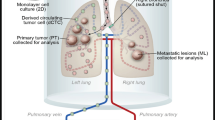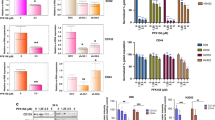Abstract
Malignant pleural mesothelioma (MPM) is resistant to chemotherapy and thus shows a dismal prognosis. Osteopontin (OPN), a secreted noncollagenous and phosphoprotein, is suggested to be involved in the pathogenesis of MPM. However, the precise role of OPN, especially in the multidrug resistance of MPM, remains to be elucidated. We therefore established stable transfectants (ACC-MESO-1/OPN), which constitutively express OPN, to determine its role in the chemoresistance observed in MPM. The introduction of the OPN gene provides MPM cells with upregulated multidrug resistance through the mechanism of enhanced hyaluronate (HA) binding. The expression of CD44 variant isoforms, which inhibit HA binding, significantly decreased in ACC–MESO–1/OPN cells in comparison to control transfectants. Interestingly, the inhibition of the HA-CD44 interaction abrogated multidrug resistance in the ACC–MESO–1/OPN, thus suggesting the involvement of the surviving signal emanating from the HA-CD44 interaction. An enhanced level of the p-Akt in ACC–MESO–1/OPN cells was observed, and was diminished by CD44 siRNA. Inhibition of the Akt phosphorylation increased in number of the cells underwent apoptosis induced by NVB, VP-16 and GEM. Collectively, these results indicate that OPN is strongly involved in multidrug resistance by enhancing the CD44 binding to HA.
This is a preview of subscription content, access via your institution
Access options
Subscribe to this journal
Receive 50 print issues and online access
$259.00 per year
only $5.18 per issue
Buy this article
- Purchase on Springer Link
- Instant access to full article PDF
Prices may be subject to local taxes which are calculated during checkout






Similar content being viewed by others
References
Boutin C, Schlesser M, Frenay C, Astoul P . (1998). Malignant pleural mesothelioma. Eur Respir J 12: 972–981.
Chahinian AP, Antman K, Goutsou M, Corson JM, Suzuki Y, Modeas C et al. (1993). Randomized phase II trial of cisplatin with mitomycin or doxorubicin for malignant mesothelioma by the Cancer and Leukemia Group B. J Clin Oncol 11: 1559–1565.
Cook AC, Chambers AF, Turley EA, Tuck AB . (2006). Osteopontin induction of hyaluronan synthase 2 expression promotes breast cancer malignancy. J Biol Chem 281: 24381–24389.
Cordo Russo RI, Garcia MG, Alaniz L, Blanco G, Alvarez E, Hajos SE . (2008). Hyaluronan oligosaccharides sensitize lymphoma resistant cell lines to vincristine by modulating P-glycoprotein activity and PI3K/Akt pathway. Int J Cancer 122: 1012–1018.
Damiano JS, Cress AE, Hazlehurst LA, Shtil AA, Dalton WS . (1999). Cell adhesion mediated drug resistance (CAM-DR): role of integrins and resistance to apoptosis in human myeloma cell lines. Blood 93: 1658–1667.
De Pangher Manzini V, Brollo A, Franceschi S, De Matthaeis M, Talamini R, Bianchi C . (1993). Prognostic factors of malignant mesothelioma of the pleura. Cancer 72: 410–417.
Denhardt DT, Noda M, O'Regan AW, Pavlin D, Berman JS . (2001). Osteopontin as a means to cope with environmental insults: regulation of inflammation, tissue remodeling, and cell survival. J Clin Invest 107: 1055–1061.
Elliott T, Sethi T . (2002). Integrins and extracellular matrix: a novel mechanism of multidrug resistance. Expert Rev Anticancer Ther 2: 449–459.
Ghatak S, Misra S, Toole BP . (2002). Hyaluronan oligosaccharides inhibit anchorage-independent growth of tumor cells by suppressing the phosphoinositide 3-kinase/Akt cell survival pathway. J Biol Chem 277: 38013–38020.
Graessmann M, Berg B, Fuchs B, Klein A, Graessmann A . (2007). Chemotherapy resistance of mouse WAP-SVT/t breast cancer cells is mediated by osteopontin, inhibiting apoptosis downstream of caspase-3. Oncogene 26: 2840–2850.
Grigoriu BD, Scherpereel A, Devos P, Chahine B, Letourneux M, Lebailly P et al. (2007). Utility of osteopontin and serum mesothelin in malignant pleural mesothelioma diagnosis and prognosis assessment. Clin Cancer Res 13: 2928–2935.
Hazlehurst LA, Landowski TH, Dalton WS . (2003). Role of the tumor microenvironment in mediating de novo resistance to drugs and physiological mediators of cell death. Oncogene 22: 7396–7402.
Hughes A, Calvert P, Azzabi A, Plummer R, Johnson R, Rusthoven J et al. (2002). Phase I clinical and pharmacokinetic study of pemetrexed and carboplatin in patients with malignant pleural mesothelioma. J Clin Oncol 20: 3533–3544.
Iida N, Bourguignon LY . (1997). Coexpression of CD44 variant (v10/ex14) and CD44S in human mammary epithelial cells promotes tumorigenesis. J Cell Physiol 171: 152–160.
Jackman DM, Kindler HL, Yeap BY, Fidias P, Salgia R, Lucca J et al. (2008). Erlotinib plus bevacizumab in previously treated patients with malignant pleural mesothelioma. Cancer 113: 808–814.
Khan SA, Cook AC, Kappil M, Gunthert U, Chambers AF, Tuck AB et al. (2005). Enhanced cell surface CD44 variant (v6, v9) expression by osteopontin in breast cancer epithelial cells facilitates tumor cell migration: novel post-transcriptional, post-translational regulation. Clin Exp Metastasis 22: 663–673.
Kindler HL, Millard F, Herndon II JE, Vogelzang NJ, Suzuki Y, Green MR . (2001). Gemcitabine for malignant mesothelioma: a phase II trial by the Cancer and Leukemia Group B. Lung Cancer 31: 311–317.
Kouniavsky G, Khaikin M, Zvibel I, Zippel D, Brill S, Halpern Z et al. (2002). Stromal extracellular matrix reduces chemotherapy-induced apoptosis in colon cancer cell lines. Clin Exp Metastasis 19: 55–60.
Li Y, Heldin P . (2001). Hyaluronan production increases the malignant properties of mesothelioma cells. Br J Cancer 85: 600–607.
Lokeshwar VB, Obek C, Soloway MS, Block NL . (1997). Tumor-associated hyaluronic acid: a new sensitive and specific urine marker for bladder cancer. Cancer Res 57: 773–777.
Misra S, Ghatak S, Zoltan-Jones A, Toole BP . (2003). Regulation of multidrug resistance in cancer cells by hyaluronan. J Biol Chem 278: 25285–25288.
Moore MJ, Goldstein D, Hamm J, Figer A, Hecht JR, Gallinger S et al. (2007). Erlotinib plus gemcitabine compared with gemcitabine alone in patients with advanced pancreatic cancer: a phase III trial of the National Cancer Institute of Canada Clinical Trials Group. J Clin Oncol 25: 1960–1966.
Ohashi R, Tajima K, Takahashi F, Cui R, Gu T, Shimizu K et al. (2009). Osteopontin modulates malignant pleural mesothelioma cell functions in vitro. Anticancer Res 29: 2205–2214.
Ohashi R, Takahashi F, Cui R, Yoshioka M, Gu T, Sasaki S et al. (2007). Interaction between CD44 and hyaluronate induces chemoresistance in non-small cell lung cancer cell. Cancer Lett 252: 225–234.
Pass HI, Lott D, Lonardo F, Harbut M, Liu Z, Tang N et al. (2005). Asbestos exposure, pleural mesothelioma, and serum osteopontin levels. N Engl J Med 353: 1564–1573.
Rangaswami H, Bulbule A, Kundu GC . (2006). Osteopontin: role in cell signaling and cancer progression. Trends Cell Biol 16: 79–87.
Ruffie PA . (1991). Pleural mesothelioma. Curr Opin Oncol 3: 328–334.
Rusch VW, Venkatraman ES . (1999). Important prognostic factors in patients with malignant pleural mesothelioma, managed surgically. Ann Thorac Surg 68: 1799–1804.
Samson MK, Wasser LP, Borden EC, Wanebo HJ, Creech RH, Phillips M et al. (1987). Randomized comparison of cyclophosphamide, imidazole carboxamide, and adriamycin versus cyclophosphamide and adriamycin in patients with advanced stage malignant mesothelioma: a Sarcoma Intergroup Study. J Clin Oncol 5: 86–91.
Sethi T, Rintoul RC, Moore SM, MacKinnon AC, Salter D, Choo C et al. (1999). Extracellular matrix proteins protect small cell lung cancer cells against apoptosis: a mechanism for small cell lung cancer growth and drug resistance in vivo. Nat Med 5: 662–668.
Sohara Y, Ishiguro N, Machida K, Kurata H, Thant AA, Senga T et al. (2001). Hyaluronan activates cell motility of v-Src-transformed cells via Ras-mitogen-activated protein kinase and phosphoinositide 3-kinase-Akt in a tumor-specific manner. Mol Biol Cell 12: 1859–1868.
Sugarbaker DJ, Garcia JP, Richards WG, Harpole Jr DH, Healy-Baldini E, DeCamp Jr MM et al. (1996). Extrapleural pneumonectomy in the multimodality therapy of malignant pleural mesothelioma. Results in 120 consecutive patients. Ann Surg 224: 288–294; discussion 294–6.
Takahashi F, Akutagawa S, Fukumoto H, Tsukiyama S, Ohe Y, Takahashi K et al. (2002). Osteopontin induces angiogenesis of murine neuroblastoma cells in mice. Int J Cancer 98: 707–712.
Takahashi K, Takahashi F, Hirama M, Tanabe KK, Fukuchi Y . (2003). Restoration of CD44S in non-small cell lung cancer cells enhanced their susceptibility to the macrophage cytotoxicity. Lung Cancer 41: 145–153.
Thylen A, Levin-Jacobsen AM, Hjerpe A, Martensson G . (1997). Immunohistochemical differences between hyaluronan- and non-hyaluronan-producing malignant mesothelioma. Eur Respir J 10: 404–408.
Toole BP . (2004). Hyaluronan: from extracellular glue to pericellular cue. Nat Rev Cancer 4: 528–539.
Uhm JH, Dooley NP, Kyritsis AP, Rao JS, Gladson CL . (1999). Vitronectin, a glioma-derived extracellular matrix protein, protects tumor cells from apoptotic death. Clin Cancer Res 5: 1587–1594.
Usami N, Fukui T, Kondo M, Taniguchi T, Yokoyama T, Mori S et al. (2006). Establishment and characterization of four malignant pleural mesothelioma cell lines from Japanese patients. Cancer Sci 97: 387–394.
White SC, Anderson H, Jayson GC, Ashcroft L, Ranson M, Thatcher N . (2000). Randomised phase II study of cisplatin-etoposide versus infusional carboplatin in advanced non-small-cell lung cancer and mesothelioma. Ann Oncol 11: 201–206.
Zoltan-Jones A, Huang L, Ghatak S, Toole BP . (2003). Elevated hyaluronan production induces mesenchymal and transformed properties in epithelial cells. J Biol Chem 278: 45801–45810.
Acknowledgements
This work was supported in part by a Grants-in-Aid for Cancer Research from the Ministry of Education, Culture, Sports, Science and Technology of Japan (K.T. No 19590914).
Author information
Authors and Affiliations
Corresponding author
Rights and permissions
About this article
Cite this article
Tajima, K., Ohashi, R., Sekido, Y. et al. Osteopontin-mediated enhanced hyaluronan binding induces multidrug resistance in mesothelioma cells. Oncogene 29, 1941–1951 (2010). https://doi.org/10.1038/onc.2009.478
Received:
Revised:
Accepted:
Published:
Issue Date:
DOI: https://doi.org/10.1038/onc.2009.478
Keywords
This article is cited by
-
Differential regulation of the sphere formation and maintenance of cancer-initiating cells of malignant mesothelioma via CD44 and ALK4 signaling pathways
Oncogene (2018)
-
CD44 and its ligand hyaluronan as potential biomarkers in malignant pleural mesothelioma: evidence and perspectives
Respiratory Research (2017)
-
Control of the MYC-eIF4E axis plus mTOR inhibitor treatment in small cell lung cancer
BMC Cancer (2015)
-
Prognostic value of several biomarkers for the patients with malignant pleural mesothelioma
Tumor Biology (2015)
-
Anti-apoptotic effects of osteopontin through the up-regulation of Mcl-1 in gastrointestinal stromal tumors
World Journal of Surgical Oncology (2014)



